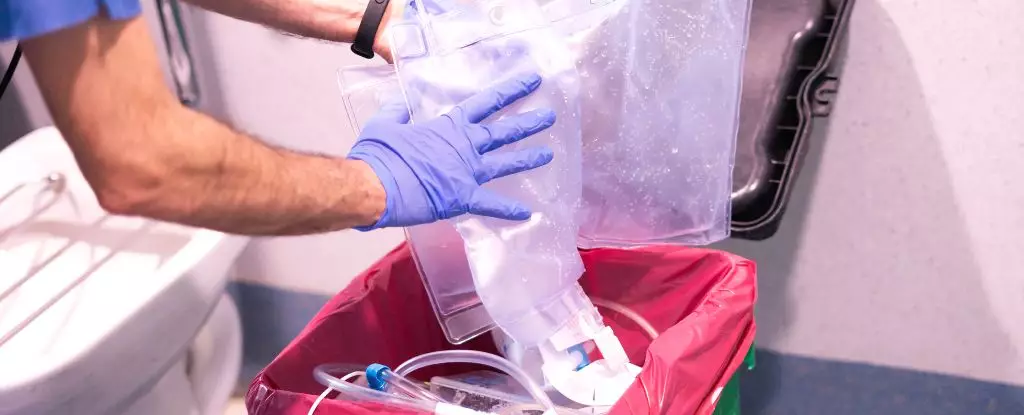Plastic pollution stands as one of the foremost environmental crises of our era, with its dire consequences felt across ecosystems, wildlife, and human health. As we grapple with the overwhelming burden of plastic waste that fills our landfills and oceans, a notable discovery has emerged in the form of rare microbes capable of decomposing plastics. While this breakthrough offers a glimmer of hope for sustainable waste management, it simultaneously invites a deeper examination of the complexities surrounding these organisms, particularly within settings that are usually bastions of health, such as hospitals.
Microbial Marvels: The Quest to Combat Plastic Waste
Recent advancements in microbiology have brought to light the astonishing capabilities of certain bacteria in breaking down plastics. These microbial agents, often dubbed “plastic-eating” microbes, hold the potential to revolutionize waste disposal methods and, ultimately, contribute to a more sustainable future. However, this optimistic view must be contrasted with the reality of potential hazards associated with their application in sensitive environments. The duality of their existence poses significant questions regarding the safety and efficacy of using these microbes in real-world applications.
Pathogens and Plastics: A Dangerous Coexistence
Delving deeper into the interaction between humanity’s most daunting health threats and the modern materials we rely upon, researchers have sought to investigate whether hospital pathogens possess the same enzymes that allow environmental bacteria to degrade plastic. This line of inquiry bears importance against the backdrop of the vast quantities of plastic used in medical applications—as sutures, implants, and wound dressings, just to name a few. When scientists studied the genomes of well-known hospital pathogens, the findings revealed a disturbing possibility: some notorious bacteria, such as Pseudomonas aeruginosa, may also have the tools to consume plastic.
Pseudomonas aeruginosa: A Pathogen with Unexpected Abilities
Pseudomonas aeruginosa is a formidable adversary in the battle against healthcare-associated infections, accounting for approximately 559,000 deaths each year globally. This pathogen thrives in hospital settings, particularly among patients who are more vulnerable due to surgical wounds or ventilator usage. Researchers, intrigued by the genetic findings, set out to validate P. aeruginosa’s potential to decompose plastic in laboratory settings. The results were striking: a specific strain of this bacterium not only demonstrated the ability to break down plastic, but it also utilized it as a nutrient source to proliferate.
This significant discovery has profound implications. The enzyme responsible for this plastic degradation, identified and named Pap1, represents a double-edged sword. On one hand, it provides a novel approach to dealing with plastic waste; on the other, it enhances the pathogenicity of P. aeruginosa. The implications of a germ capable of both decomposing waste and thriving on materials found in medical environments require an urgent reassessment of infection control measures.
Biofilms: The Protective Fortress of Pseudomonas Aeruginosa
Pseudomonas aeruginosa’s ability to form robust biofilms poses yet another level of complexity. These biofilms act as protective armor, shielding the bacteria from both the human immune response and conventional antibiotics. Remarkably, the presence of degraded plastic seems to bolster the dimensions of these biofilms, allowing the pathogen to create stronger and thicker layers using plastic fragments as a structural component. This revelation raises alarm bells about the implications for patient care, as the microbe capitalizes on medical materials, potentially exacerbating infections.
In the high-stakes environment of healthcare, the persistent presence of P. aeruginosa underscores a pressing need for vigilance. The potential for this pathogen to actively eat plastics in medical devices could compromise treatment outcomes, leading to heightened risks for patients who are already compromised due to illness or injury.
Looking Forward: Innovations and Considerations
In response to this alarming new understanding, scientists are actively working on innovative solutions that incorporate antimicrobial technologies into medical plastics to mitigate the risks posed by “plastic-eating” germs. As we gaze into the future, it is crucial for researchers, medical professionals, and policymakers to develop a comprehensive strategy that carefully weighs the benefits of these microorganisms against their threats, particularly in hospitals and other healthcare settings.
Ultimately, this unique intersection of microbiology, environmental science, and public health showcases the need to tread carefully as we explore novel methods for managing plastic waste—balancing innovation with the health and safety of individuals who depend on medical advancements grounded in plastic.

